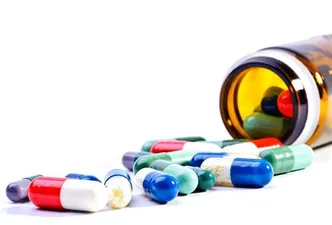Absorption of drugs by Passive Diffusion.
Passive Diffusion
Also called non-ionic diffusion, it is the major process for absorption of more than 90% of the drugs.
The driving force for this process is the concentration or electrochemical gradient. It is defined as the difference in the drug concentration on either side of the membrane.
Drug movement is a result of the kinetic energy of molecules. Since no energy source is required, the process is called passive diffusion.
Passive diffusion is best expressed by Fick's first law of diffusion which states that the transfer of drug molecules takes place from a region of higher concentration to lower concentration until equilibrium is attained and that the rate of diffusion is directly proportional to the concentration gradient across the membrane.
It can be mathematically expressed by the following equation:
where,
dQ/dt = rate of drug diffusion (amount/time). It also represents the rate of appearance of drug in blood
D = diffusion coefficient of the drug through the membrane (area/time)
A = surface area of the absorbing membrane for drug diffusion (area)
Km/w = partition coefficient of the drug between the lipoidal membrane and the aqueous GI fluids (no units)
(CGIT-C) = difference in the concentration of drug in the GI fluids and the plasma, called as the concentration gradient (amount/volume)
h = thickness of the membrane (length)
Characteristics of passive diffusion:
The drug moves down the concentration gradient indicating downhill transport.
The process is energy-independent and non-saturable.
The rate of drug transfer is directly proportional to the concentration gradient between Gl fluids and the blood compartment.
Greater the area and lesser the thickness of the membrane, faster the diffusion; thus, more rapid is the rate of drug absorption from the intestine than from the stomach.
The process is rapid for short distances and slower for long distances.
Equilibrium is attained when the concentration on either side of the membrane becomes equal.
Rate of transfer of unionized species is 3 to 4 times the rate for ionized drugs.
Greater the membrane/water partition coefficient of drug, faster the absorption; since the membrane is lipoidal in nature, a lipophilic drug diffuses at a faster rate.
The drug diffuses rapidly when the volume of GI fluid is low; conversely, dilution of GI fluids decreases the drug concentration in these fluids (CGrr) and lower the concentration gradient (CGIT C).
The process is dependent, to a lesser extent, on the square root of the molecular size of the drug. The diffusion generally decreases with increase in the molecular weight of the compound. exceptions-for example, cyclosporin A,
Initially, when the drug is ingested, CGIT >> C and a large concentra gradient exists thereby acting as the driving force for absorption. As equilibrium approaches, the drug diffusion should stop and consequently large fraction of drugs may remain unabsorbed. But this is not the case; the passively absorbed drug enters blood, it is rapidly swept away and distributed into a much larger volume of body fluids and hence, the penetration of drug at the absorption site, CGIT, is maintained with greater concentration of drug in plasma. Such a condition is called a Sink condition for drug absorption.
Commonly asked questions.
Write a short note on “Absorption of drugs by Passive diffusion”.
What is Fick’s first law of diffusion, explaining characteristics of passive diffusion of drugs.
Labels: Biopharmaceutics


